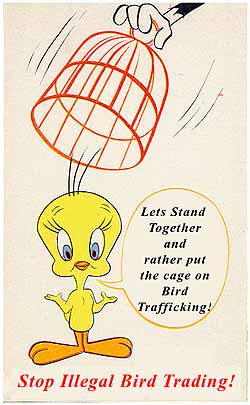![]() Plight of illegally traded birds highlighted at Windhoek show
Plight of illegally traded birds highlighted at Windhoek show
[The Namibian
-- 4 October 2012]
 THE African Grey parrot is at
risk of going extinct because of the scourge of illegal trapping and trading
of the species, the Avicultural Association of Namibia (AAN) has warned.
AAN, a self-policing voluntary group of bird breeders, is exhibiting at
the Windhoek Agricultural and Industrial Show this week to enlighten people
about the dangers of illegal bird trade and is assisted by the Namibia
Animal Rehabilitation Research and Education Centre (Narrec) in its campaign
to raise public awareness.
THE African Grey parrot is at
risk of going extinct because of the scourge of illegal trapping and trading
of the species, the Avicultural Association of Namibia (AAN) has warned.
AAN, a self-policing voluntary group of bird breeders, is exhibiting at
the Windhoek Agricultural and Industrial Show this week to enlighten people
about the dangers of illegal bird trade and is assisted by the Namibia
Animal Rehabilitation Research and Education Centre (Narrec) in its campaign
to raise public awareness.
Narrec together with AAN is highlighting the issue of illegal trade through posters and flyers displayed at the stall.
Because of the voluntary nature of AAN not everyone who associate with the group adheres to proposed norms and standards and these standards may even be ignored by its members, most of whom breed and trade with parrot species.
In order to trade with wildlife, a permit is required from the Ministry of Environment and Tourism and in order to breed and sell parrot species the birds must have permanent identification.
This is done with a closed ring fitted over the baby bird’s foot so that once the bird has grown the ring can no longer slip off the foot. The ring provides an identification proving that the bird was bred in captivity. This method is very poorly enforced and many members of the public do not seem to know that buying a parrot without a closed ring is buying a bird that may have been illegally caught in the wild.
Aviculture is one of the greatest threats to parrot species globally. A case in point is the extinction of the Spix’s Macaw, a beautiful blue bird poached to extinction in the 1990s just across the Atlantic Ocean in Brazil. It is the ease of transporting birds, the lack of local inspection and enforcement by authorities and the lack of information given to the general public that puts all bird species at risk of unscrupulous action.
Africa has its own parrot species at risk and on a continental scale the African Grey parrot is most at risk from the scourge of illegal trapping and trading.
Jamie Gilardi, the executive director of the World Parrot Trust, writes: “If you care about wildlife, nature, your pets, our planet, and all things good, you need to support the suspension of all trade in grey parrots from Cameroon and the Democratic Republic of Congo (DRC). Thousands of these long-lived, intelligent parrots are ripped out of the wild every year, packed into cramped travel crates, fed on mouldy peanuts, and then sold into the lucrative wildlife trade.
“Many die from exhaustion or fatal injury in nets and snares or from dehydration, disease and stress in rudimentary wooden crates when being stored, transported and sold by local trappers. Even more die in crammed travel crates in transit to rural markets where thousands of grey parrots are collected by exporters and quarantined until they are sold, euthanised or die....”
Namibia is one of the countries through which birds are trafficked, with a busy port through which birds can be moved around the globe. .
On a national scale Namibia’s five parrot species are all at risk of illegal trade and this trade can only be limited by the factor of the connection between demand and supply. The more people are aware of the inhumane treatment of animals during trafficking operations, the closer we can get to blocking the demand for wild caught birds.
 Liz
Komen
Liz
Komen
NARREC